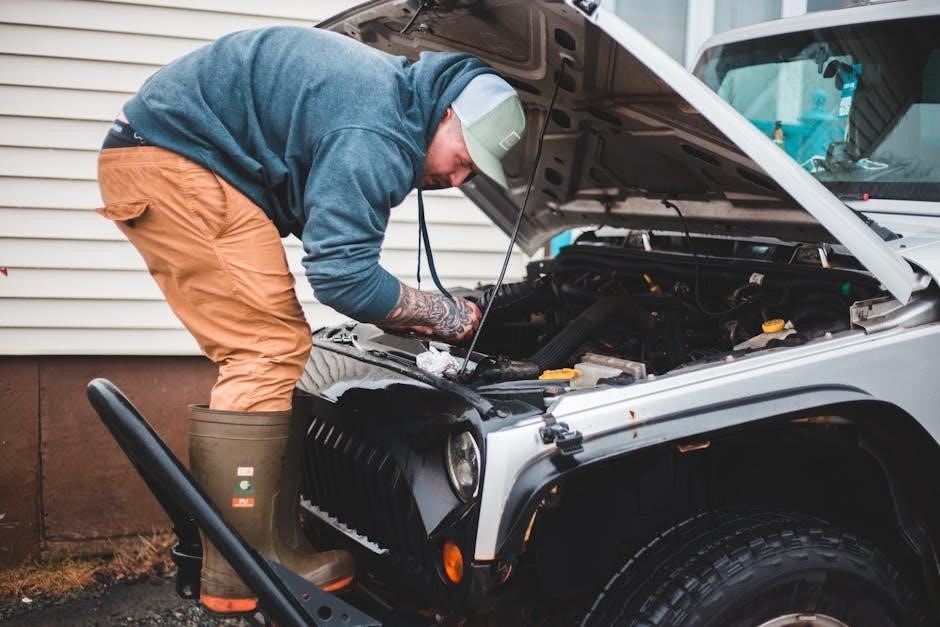The Jeep JK manual transmission‚ specifically the NSG370 6-speed‚ offers precise control and enhanced performance for both on-road and off-road driving‚ making it a popular choice among enthusiasts.
Overview of the Jeep JK and Its Transmission Options
The Jeep JK‚ produced from 2007 to 2018‚ is a versatile off-road vehicle known for its ruggedness and capability. It offers two primary transmission options: an automatic and a manual. The manual transmission‚ particularly the NSG370 6-speed‚ has gained popularity among off-road enthusiasts due to its durability and control in challenging terrains. The NSG370 provides a six-speed setup with a lower first gear for improved crawling and a higher sixth gear for highway efficiency. This transmission is paired with a hydraulic clutch system‚ offering smooth engagement and precise control. The manual option is favored for its driver engagement and cost-effectiveness compared to the automatic. Its design aligns with the Jeep JK’s off-road focus‚ making it a preferred choice for adventure-seekers.
The Popularity of Manual Transmissions in Off-Road Vehicles
Manual transmissions remain a popular choice for off-road enthusiasts‚ particularly in vehicles like the Jeep JK. The ability to maintain precise control over gear shifts is crucial in challenging terrains‚ where automatic transmissions may hesitate or lack the necessary finesse. Manual transmissions allow drivers to modulate power delivery effectively‚ which is essential for rock crawling‚ hill climbing‚ and navigating uneven surfaces. Additionally‚ the lower first gear in manual transmissions provides better slow-speed crawling capability‚ while the higher sixth gear enhances highway efficiency. For many off-road enthusiasts‚ the tactile connection and driver engagement offered by a manual transmission are irreplaceable‚ making it a preferred choice for adventurous driving;

Understanding the NSG370 6-Speed Manual Transmission
The NSG370 is a durable 6-speed manual transmission designed for the Jeep JK‚ offering smooth shifting and reliable performance for both on-road and off-road driving.
History and Development of the NSG370 Transmission
The NSG370 transmission was first introduced in the late 1990s as a 6-speed manual gearbox designed for rugged applications. It was initially used in various Chrysler and Jeep models before becoming a staple in the Jeep JK lineup starting in 2007. Developed to meet the demands of off-road enthusiasts‚ the NSG370 was refined over the years to improve durability and performance. Its design focused on providing precise control and strength‚ making it ideal for the Jeep JK’s adventurous capabilities. Over time‚ minor updates were made to address reliability concerns‚ solidifying its reputation as a reliable workhorse for both on-road and off-road driving scenarios. This transmission has become a favorite among Jeep enthusiasts for its robust construction and versatility.
Key Features of the NSG370 Transmission
The NSG370 transmission is a robust 6-speed manual gearbox designed for the Jeep JK‚ offering a blend of durability and performance. It features a reinforced gear set with optimized ratios for both on-road and off-road driving. The transmission includes a two-piece aluminum case for improved heat dissipation and reduced weight. Its triple-cone synchronizers enhance shifting smoothness‚ especially in challenging conditions. The dual-mass clutch system minimizes vibrations and provides a smoother pedal feel. Additionally‚ the compact and lightweight design contributes to better fuel efficiency and vehicle agility. These features collectively ensure the NSG370 is well-suited for the Jeep JK’s adventurous capabilities.
Technical Specifications of the NSG370 Transmission
The NSG370 transmission features a 6-speed manual design with a gear ratio spread of 4.46:1 in first gear to 0.84:1 in sixth gear. It has a torque capacity of up to 260 lb-ft‚ making it suitable for off-road demands. The transmission weighs approximately 105 pounds and uses a two-piece aluminum case for durability and heat dissipation. It incorporates a hydraulic clutch system with a dual-mass flywheel for smoother engagement. The NSG370 also includes a transmission oil cooler for thermal management. With a lubrication capacity of about 2.5 quarts‚ it ensures optimal performance in harsh conditions. These specifications make the NSG370 a reliable choice for the Jeep JK’s adventurous capabilities.
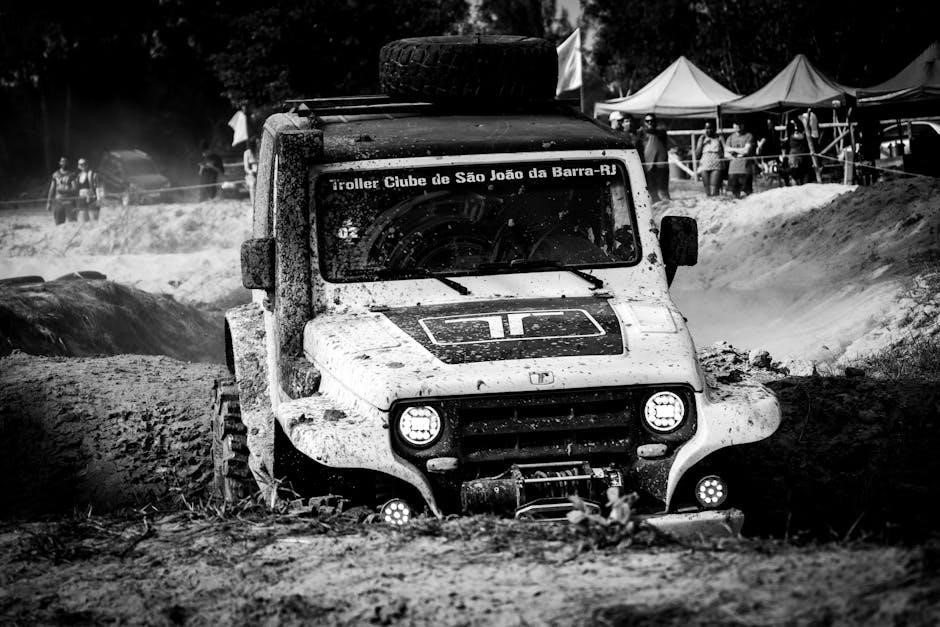
Common Issues with the Jeep JK Manual Transmission
The Jeep JK manual transmission often experiences difficulties with gear shifting‚ clutch slippage‚ and premature wear. Issues like rough engagement and unexpected gear popping are common‚ especially during off-road use‚ due to heavy stress on the system. Owners frequently report noises and vibrations‚ which can indicate internal wear or alignment problems. These issues typically arise from excessive wear and tear‚ heavy off-road use‚ or lack of proper maintenance‚ making regular inspections and timely repairs essential to ensure optimal performance and longevity.

Difficult Gear Shifting and Rough Engagement
Difficult gear shifting and rough engagement are common issues in the Jeep JK manual transmission‚ particularly in the NSG370 model. These problems often stem from worn-out synchronizers or bearings within the transmission‚ which can degrade over time due to heavy use or lack of maintenance. Drivers may experience grinding or hesitation when shifting into gears‚ especially when transitioning from first to second or reverse. Additionally‚ rough engagement can be exacerbated by clutch system misalignment or improper pedal adjustment. Environmental factors‚ such as extreme temperatures‚ may also contribute to these issues. Regular inspection of the clutch and transmission components‚ along with proper fluid levels‚ can help mitigate these problems. Addressing these concerns early is crucial to prevent further damage and ensure smooth operation.
Clutch Slippage and Premature Wear

Clutch slippage and premature wear are significant concerns for Jeep JK owners with manual transmissions. Slippage occurs when the clutch fails to fully engage‚ causing a loss of power transfer to the wheels. This is often due to worn or glazed clutch facings‚ incorrect pedal adjustment‚ or driver error‚ such as riding the clutch. Premature wear can result from aggressive driving‚ frequent stop-and-go traffic‚ or towing heavy loads. Symptoms include a burning smell‚ noise during acceleration‚ and a spongy or loose pedal feel. If left unaddressed‚ clutch issues can lead to costly repairs‚ including replacement of the entire clutch system. Regular inspections and proper driving techniques are essential to extend clutch life and maintain optimal performance. Addressing these issues early ensures reliable operation and prevents further damage to the transmission.
First and Reverse Gear Popping Out
First and reverse gear popping out is a common issue in the Jeep JK manual transmission‚ particularly in heavily used or high-mileage vehicles. This occurs when the transmission disengages from first or reverse gear unexpectedly‚ often during acceleration or deceleration. The problem is typically linked to worn or damaged synchronizers‚ a faulty detent spring‚ or a worn-out gearset. Symptoms include the gear slipping out without warning‚ making it difficult to stay in gear‚ especially in low-speed or off-road conditions. If left unaddressed‚ this issue can lead to further damage‚ such as worn gears or even transmission failure. Drivers experiencing this problem should have their transmission inspected and repaired by a qualified mechanic to prevent costly complications. Regular maintenance and early intervention are crucial to resolving this issue effectively.
Noises and Vibrations During Operation
Noises and vibrations during operation are common issues in the Jeep JK manual transmission‚ often indicating underlying mechanical problems. Grinding or clunking sounds may signal worn bearings‚ damaged gear teeth‚ or a failing synchronizer ring. Vibrations could result from misaligned or loose transmission mounts‚ while whining noises might point to low transmission fluid levels or improper lubrication. In some cases‚ a malfunctioning pilot bearing or a warped flywheel can also cause vibrations. Ignoring these symptoms can lead to more severe damage‚ such as gear failure or transmission breakdown. Regular inspections‚ fluid checks‚ and timely repairs are essential to address these issues before they escalate. Addressing these problems early helps maintain smooth operation and extends the life of the transmission.
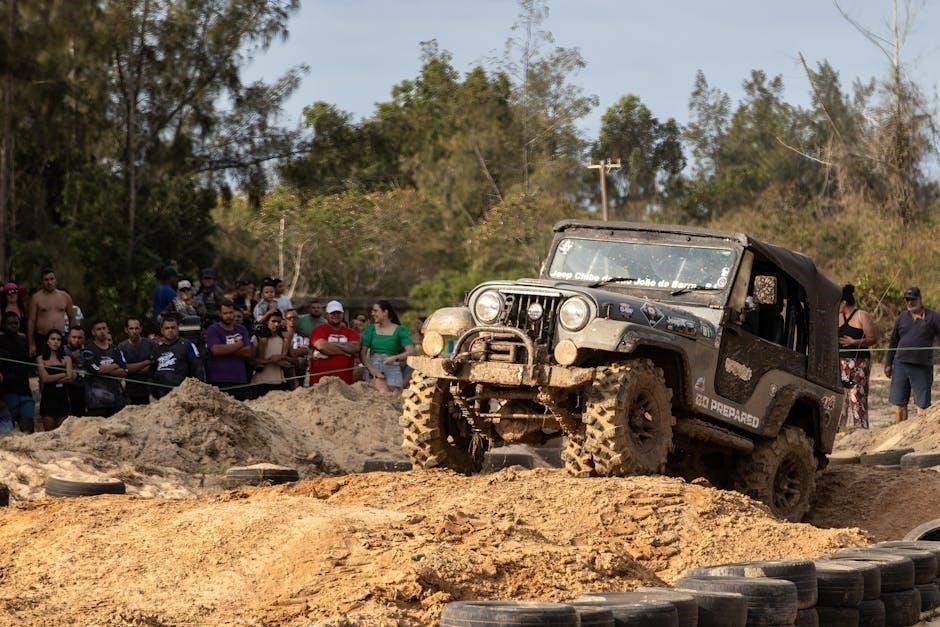
Maintenance Tips for the Jeep JK Manual Transmission
Regular inspections of the transmission mounts and drivetrain components are crucial to ensure smooth operation. Checking for fluid leaks and monitoring clutch pedal feel helps prevent issues. Always use genuine parts for replacements to maintain performance and durability. Timely servicing and proper lubrication are key to extending the transmission’s lifespan.
Importance of Regular Transmission Fluid Changes
Regular transmission fluid changes are vital for maintaining the health and performance of the Jeep JK’s manual transmission. The fluid lubricates gears‚ prevents overheating‚ and ensures smooth shifting. Over time‚ the fluid can degrade‚ losing its ability to protect components. Old or contaminated fluid can lead to premature wear‚ corrosion‚ and even transmission failure. Jeep recommends changing the transmission fluid every 30‚000 to 60‚000 miles‚ depending on driving conditions. For off-road use‚ more frequent changes are advised due to increased heat and stress. Always use the specified fluid type to maintain optimal performance and extend the transmission’s lifespan. Neglecting fluid changes can result in costly repairs down the road.
Inspecting and Replacing the Clutch System
Inspecting and replacing the clutch system in your Jeep JK manual transmission is crucial for maintaining smooth and precise gear engagement. Over time‚ the clutch disc‚ pressure plate‚ and release bearing can wear out‚ leading to slippage or failure. Regular inspection involves checking the clutch pedal for excessive play‚ listening for unusual noises during shifting‚ and monitoring for signs of slipping‚ such as a loss of power when accelerating. If significant wear is detected‚ replacing the clutch system is necessary to prevent further damage to the transmission. The process typically involves removing the transmission‚ inspecting the flywheel for damage‚ and installing a new clutch kit. Proper installation ensures optimal performance and prevents premature wear on other components.
Adjusting the Clutch Pedal and Linkage
Proper adjustment of the clutch pedal and linkage is essential for smooth and precise gear engagement in the Jeep JK manual transmission. Over time‚ the clutch pedal may develop excessive play or become too stiff‚ leading to inconsistent shifting. To adjust the pedal‚ start by locating the adjustment nut on the clutch master cylinder rod. Loosen the locknut and turn the adjustment nut to achieve the recommended pedal height and free play‚ typically around 1-2 inches of free play at the pedal. Tighten the locknut after adjustment. Ensuring the clutch pedal operates smoothly prevents wear on the clutch system and enhances overall driving performance. Regular checks and adjustments can help maintain optimal functionality and driver control.
Using the Correct Gear Oil for Optimal Performance
The correct gear oil is essential for the smooth operation and longevity of the Jeep JK’s manual transmission. Using the wrong type or viscosity can lead to premature wear‚ increased friction‚ and even transmission failure. The NSG370 transmission requires a high-quality GL-4 or GL-5 rated gear oil to ensure proper lubrication and heat management. It’s crucial to follow the manufacturer’s recommendations‚ as specified in the owner’s manual‚ to avoid potential damage. Regular oil changes‚ typically every 30‚000 to 60‚000 miles‚ are also vital to maintain optimal performance. Always check the oil level and top it off if necessary‚ especially after off-road adventures or extreme driving conditions.
Remember‚ the right gear oil ensures smooth shifting and extends the life of your transmission.

Upgrading and Modifying the Jeep JK Manual Transmission
Upgrading the Jeep JK manual transmission can enhance performance and durability. Aftermarket parts‚ such as heavy-duty bearings and improved synchros‚ reduce wear and tear. Rebuilding the transmission with higher-strength components ensures reliability in extreme off-road conditions. Additionally‚ installing an aftermarket short-throw shifter or hydraulic bearing can improve shifting precision and driver control.
Aftermarket Parts for Enhanced Performance
Aftermarket parts can significantly enhance the performance of the Jeep JK manual transmission. Upgrading the shifter with a shorter throw unit improves shifting precision and reduces effort. Heavy-duty clutch kits‚ such as those with ceramic or organic friction materials‚ provide better durability and increased torque capacity for off-road use. Lightened flywheels reduce rotational mass‚ allowing for quicker engine response. Additionally‚ aftermarket gear sets with optimized ratios can improve low-end grunt for rock crawling or high-speed performance on the highway. Transmission mounts and drivetrain components‚ like limited-slip differentials‚ further enhance stability and control. These modifications not only boost performance but also ensure reliability in demanding conditions.
Rebuilding vs. Replacing the Transmission
When deciding between rebuilding and replacing the NSG370 transmission in your Jeep JK‚ it’s essential to consider the extent of damage and your budget. Rebuilding involves using the existing transmission case and replacing worn or damaged internal components‚ which can be cost-effective if the damage is localized. This approach also allows for customization with aftermarket parts for improved performance. On the other hand‚ replacing the transmission with a new or remanufactured unit provides a warranty and ensures all components are in like-new condition. However‚ this option is typically more expensive. Factors like labor costs‚ time‚ and the vehicle’s intended use should also influence your decision. Consulting a qualified mechanic can help determine the best route for your Jeep JK.
Cost Considerations for Transmission Upgrades
Upgrading the Jeep JK manual transmission can vary significantly in cost‚ depending on the type of modifications or replacements. Basic aftermarket components‚ such as gears or bearings‚ may range from $500 to $1‚500. However‚ a full transmission rebuild kit‚ including high-performance parts‚ can cost between $2‚000 and $4‚000. Replacing the entire NSG370 transmission with a remanufactured unit can range from $3‚500 to $5‚500‚ depending on the quality and source. Labor costs for installation or rebuilding add another $1‚000 to $2‚500‚ depending on the complexity of the job and the mechanic’s rates. Additionally‚ upgrading to a heavy-duty transmission for extreme off-road use can exceed $6‚000. Balancing performance needs with budget is crucial for Jeep owners considering transmission upgrades.
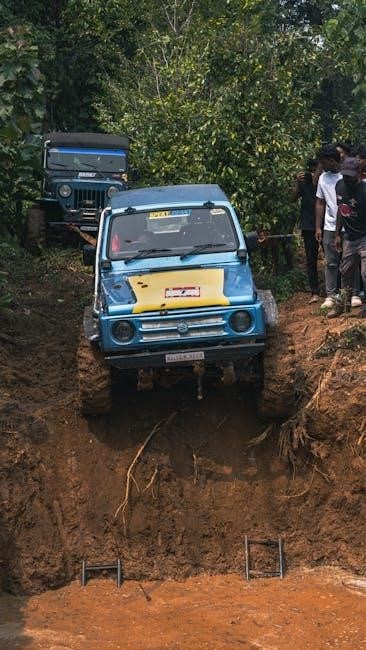
Driving Techniques for Manual Transmission Jeep JK

Mastering driving techniques for the Jeep JK manual transmission enhances both on-road and off-road performance. Smooth acceleration‚ precise gear shifts‚ and controlled throttle input ensure optimal power delivery and traction in challenging conditions.
Mastering Off-Road Driving with a Manual Transmission
Mastering off-road driving with a manual transmission in a Jeep JK requires skill‚ patience‚ and practice. Throttle control is critical‚ as it helps maintain traction on uneven terrain. Using the correct gear for the terrain ensures optimal power delivery and prevents wheel spin or bogging down. Feathering the clutch gently can help avoid stalling‚ especially on steep inclines or rocky surfaces. Additionally‚ knowing when to ride the clutch is essential to prevent overheating and wear. Balancing momentum and control is key for navigating obstacles without losing stability. Finally‚ practicing on varied trails builds familiarity with the transmission’s behavior and enhances off-road driving instincts. With time and experience‚ drivers can unlock the full potential of the manual transmission in challenging off-road conditions.
Smooth Shifting Techniques for On-Road Driving
Smooth shifting techniques for on-road driving in a Jeep JK with a manual transmission are essential for optimal performance and longevity.
Start by easing off the throttle before shifting gears to reduce stress on the transmission.
Use the clutch smoothly‚ avoiding abrupt presses or releases‚ as this can cause unnecessary wear.
Match your gear selection to your speed‚ ensuring you’re not over-revving or lugging the engine.
When accelerating‚ time your shifts to keep the engine in its power band for better responsiveness.
Coasting in neutral is not recommended‚ as it can lead to loss of control.
Instead‚ downshift before slowing down to maintain control and use engine braking effectively.
Practice timing your shifts during acceleration to avoid jerky movements.
By mastering these techniques‚ you’ll enhance your driving experience and reduce wear on the transmission.
Avoiding Common Mistakes That Damage the Transmission
To prevent damage to the Jeep JK manual transmission‚ avoid common driver errors. Riding the clutch‚ where the pedal is partially pressed‚ can wear down the clutch and pressure plate; Shifting gears without fully depressing the clutch can grind gears and cause premature wear. Forgetting to downshift before stopping on an incline can strain the transmission. Sudden acceleration from a standstill‚ especially in low range‚ can stress the gears and bearings. Always use the parking brake on steep inclines to reduce transmission load. Smooth‚ gradual acceleration and deliberate shifting are key to longevity. By avoiding these habits‚ Jeep JK owners can protect their manual transmission and ensure optimal performance.
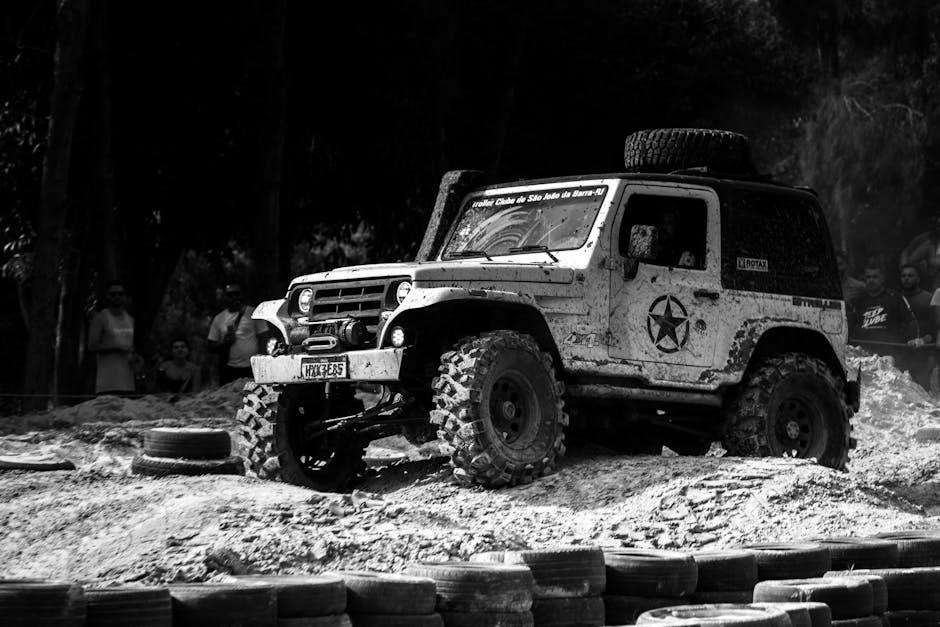
Recalls and Software Updates for the NSG370 Transmission
In 2010‚ Jeep issued a recall for the NSG370 transmission in 2007-2010 JK models due to improper gear engagement and pressure plate overheating issues. Software updates were provided to address these concerns‚ improving clutch operation and reducing the risk of premature wear.
Jeep’s Recall on the 6-Speed Manual Transmission
In 2010‚ Jeep issued a recall for certain model years of the JK equipped with the NSG370 6-speed manual transmission. The recall addressed issues related to the clutch and pressure plate‚ which could overheat and cause premature wear. This led to symptoms like clutch slippage‚ difficulty shifting gears‚ and increased risk of transmission damage. Jeep provided a Technical Service Bulletin (TSB) outlining the necessary repairs‚ which included replacing the clutch assembly and updating the transmission software. The recall was free of charge for affected owners and aimed to restore proper functionality and reliability to the manual transmission system. Drivers were encouraged to monitor for symptoms and contact dealers promptly for service.
Software Fixes for Pressure Plate Overheating
The NSG370 transmission in the Jeep JK has faced issues with pressure plate overheating‚ particularly during aggressive driving or towing. Jeep addressed this problem through software updates designed to refine the transmission’s control module. These updates adjust clutch pack engagement and disengagement patterns to reduce heat buildup. The software fix improves pressure plate performance‚ minimizing the risk of overheating and subsequent damage. While the update doesn’t eliminate all risks‚ it significantly enhances the transmission’s reliability under stress. Owners are encouraged to install the latest software to benefit from these improvements and ensure optimal transmission operation. Regular monitoring of driving conditions remains essential to prevent overheating issues.
and Final Thoughts
The Jeep JK manual transmission offers a perfect blend of durability and precision‚ delivering exceptional off-road capability and smooth on-road performance. A timeless choice for enthusiasts and everyday drivers alike‚ balancing performance with practicality.
Pros and Cons of the Jeep JK Manual Transmission
The Jeep JK manual transmission‚ particularly the NSG370‚ offers several advantages that make it a favorite among off-road enthusiasts. Pros include precise control during off-road driving‚ better fuel efficiency compared to automatic models‚ and a more engaging driving experience. The manual transmission is also lighter and more cost-effective to maintain than its automatic counterpart. Additionally‚ the direct connection between the driver and the vehicle enhances the overall off-road capability‚ making it a preferred choice for serious adventurers.
However‚ there are some cons to consider. The manual transmission can be less convenient in heavy traffic‚ requiring constant clutch and gear engagement. Some users have reported issues with reliability over time‚ particularly with the clutch system and gear engagement. Despite these drawbacks‚ the Jeep JK manual transmission remains a solid choice for those prioritizing off-road performance and driving involvement.
Future of Manual Transmissions in Jeep Vehicles
The future of manual transmissions in Jeep vehicles‚ including the Jeep JK‚ is a topic of growing interest. While automatics dominate the market‚ Jeep enthusiasts remain loyal to manuals for their off-road capability and driving engagement. Jeep has hinted at maintaining manual options in select models‚ particularly for hardcore off-roaders. However‚ the rise of electric vehicles and advanced automatics may challenge this tradition. Despite this‚ Jeep is likely to retain manuals in niche models‚ catering to purists who value control and connection to the vehicle. The integration of hybrid or electric systems with manual transmissions could emerge‚ blending tradition with innovation. For now‚ the manual transmission remains a cherished feature in Jeep’s lineup‚ ensuring its relevance for years to come.
